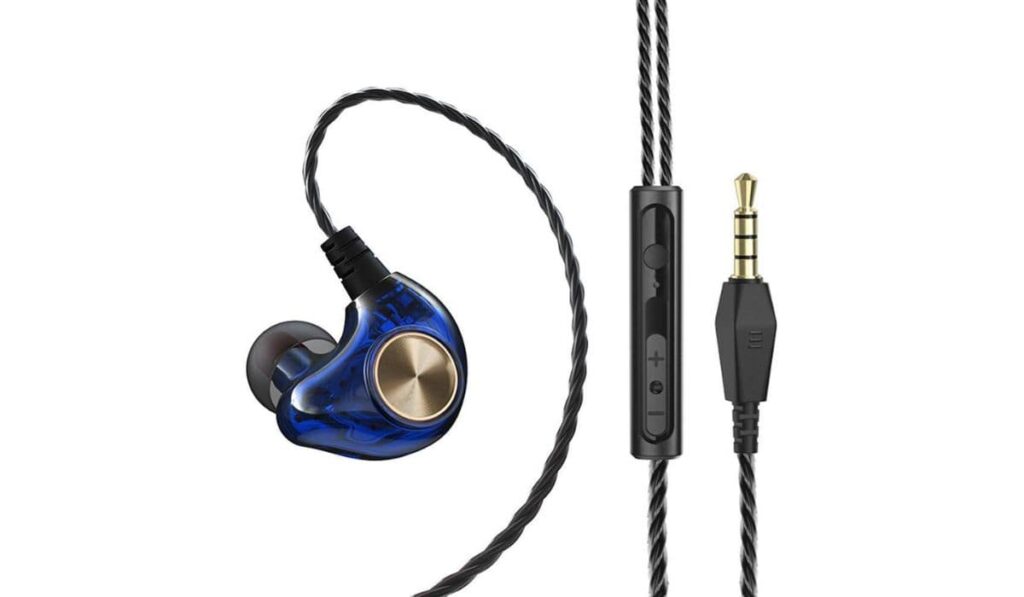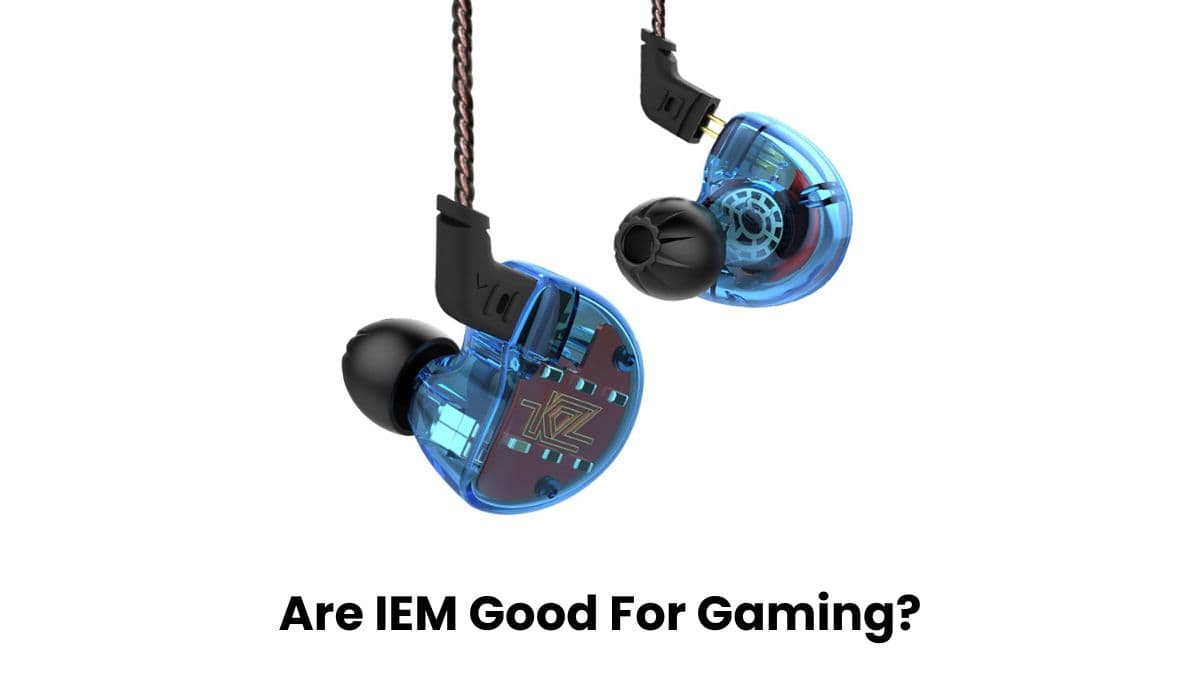In recent years, gaming has become one of the most popular pastimes worldwide, and with the rise of esports, gamers are constantly seeking ways to improve their performance. One way to enhance the gaming experience is by using in-ear monitors (IEMs).
IEMs have become increasingly popular among gamers due to their portability, comfort, and high-quality audio output. However, many gamers still wonder if IEMs are a good choice for gaming and if they can offer the same level of performance as traditional gaming headsets.
In this article, we will explore the advantages and disadvantages of using IEMs for gaming and help you determine if they are the right choice for you. Also, give you the proper answer about are IEM good for gaming or not.
Table of Contents
What are In-Ear Monitors (IEMs)?

In-ear monitors (IEMs) are a type of audio equipment that is commonly used by musicians, audio engineers, and audiophiles. Small earphones fit snugly inside the ear canal, creating a seal that blocks out external noise while providing high-quality audio playback.
Unlike traditional headphones on top of the ear or over the head, IEMs are designed to be inserted directly into the ear canal. This provides a more secure and comfortable fit and improved noise isolation. The design of IEMs also allows them to be more discreet and portable than other types of headphones, making them a popular choice for musicians and audio professionals who need to monitor sound on the go.
IEMs are commonly used in live music performances and studio recording sessions. Musicians use them to monitor their performance and to hear the other instruments in the mix. Audio engineers use them to monitor the sound being recorded or mixed, allowing them to make adjustments and ensure that the final product sounds as intended.
In addition to their use in professional settings, IEMs are also popular among audiophiles and music enthusiasts who want to experience high-quality audio playback on the go. Many IEMs are designed to deliver a balanced and detailed sound that rivals larger, more expensive headphones. Some models even feature advanced technologies like multiple drivers and adjustable sound signatures, allowing users to customize their listening experience to their preferences.
When choosing IEMs, there are several factors to consider, including sound quality, comfort, durability, and price. Some IEMs come with replaceable tips, allowing users to customize the fit and improve noise isolation. Others feature detachable cables, which can be replaced if damaged or worn over time. Some models are designed to be sweat and water-resistant, making them a good choice for active use.
Overall, in-ear monitors (IEMs) are versatile and high-quality audio tools that can be used for various purposes. Whether you’re a musician, audio professional, or music enthusiast, there’s an IEM out there that’s right for you.
Are IEM Good For Gaming?

Musicians and music lovers commonly use in-ear monitors (IEMs) to deliver high-quality audio. However, they are not often associated with gaming. So, the question is, are IEMs good for gaming? The answer is yes, and here’s why.
Firstly, IEMs provide superior noise isolation. This means you can immerse yourself in the game without external distractions. This is particularly useful when playing in noisy environments or when trying to concentrate on the game’s audio cues.
Secondly, IEMs are very portable and lightweight. Unlike over-ear headphones, IEMs are easy to carry around and can be worn for extended periods without causing any discomfort. This makes them perfect for gaming on the go or in situations where you need to be able to move around freely.
Thirdly, IEMs can deliver incredible audio clarity and detail. Gaming relies heavily on audio cues like footsteps, gunshots, and environmental sounds. IEMs can deliver these sounds with exceptional precision, allowing you to react quickly and accurately to in-game events.
Moreover, many IEMs come with a built-in microphone, which allows you to communicate with other players during multiplayer games. This is particularly useful when playing competitive games where communication is key.
However, not all IEMs are created equal. When choosing an IEM for gaming, it’s important to consider factors such as sound quality, comfort, noise isolation, and microphone quality. You must also ensure that the IEMs you choose have a compatible connection with your gaming device.
Do Pro Gamers Use IEM?

Professional gamers always seek any advantage to help them perform at their best. In-ear monitors (IEMs) are popular among pro gamers for various reasons.
Firstly, IEMs provide superior noise isolation. Pro gamers can block out any external noise and focus solely on the game’s audio cues. This is particularly important in noisy environments, such as gaming tournaments, where background noise can occur.
Secondly, IEMs are lightweight and portable. Pro gamers often travel to tournaments and events, so having a pair of IEMs they can easily pack and take with them is essential.
Thirdly, IEMs can deliver exceptional audio clarity and detail. This is crucial for pro gamers who need to hear every detail of the game’s audio to make quick and accurate decisions. IEMs can provide better audio quality than traditional gaming headsets, so pro gamers often prefer them.
Moreover, many pro gamers prefer IEMs because they are less bulky and cumbersome than traditional gaming headsets. This can make it easier for them to move around and react quickly to in-game events.
However, it’s worth noting that not all pro gamers use IEMs. Some may prefer traditional gaming headsets or speakers, depending on their preferences and gaming style.
Are IEMs Better Than Headsets?

The debate between in-ear monitors (IEMs) and headsets has been ongoing for quite some time, and both sides have valid arguments. However, determining which is better depends on your preferences and intended use.
IEMs are designed to fit snugly in your ear canal, blocking external noise and providing a more immersive listening experience. They are often used by musicians and audiophiles who value sound quality and isolation. IEMs are also more portable and easier to carry around than headsets, making them a popular choice for people who are always on the go.
On the other hand, headsets are designed to be worn over your ears, with a headband that fits securely on your head. They are commonly used for gaming, video conferencing, and other activities where communication is essential. Headsets often have built-in microphones, making them a convenient voice communication choice. They are also more comfortable to wear for extended periods, as they distribute the weight of the headphones across the top of your head.
Regarding sound quality, both IEMs and headsets can produce high-quality audio. However, IEMs offer a more natural sound, creating a seal in your ear canal for better isolation and clarity.
On the other hand, headsets often have larger drivers and can produce more powerful bass, which can be preferable for certain genres of music.
In terms of pricing, IEMs, and headsets can range from very affordable to very expensive. However, IEMs are more expensive, often featuring more advanced technology and materials.
Ultimately, whether IEMs or headsets are better depends on your preferences and intended use. If you prioritize sound quality and isolation, IEMs may be the better choice. If you need a headset for gaming or communication or prefer something more comfortable for extended wear, a headset may be the better option.
Also Read: How To Wear On-Ear Headphones Comfortably
Advantages of Using IEM:
In-ear monitors (IEMs) have become increasingly popular among musicians, audio engineers, and audiophiles. These devices offer a range of advantages over traditional headphones or earbuds, including:
1. Improved sound quality
IEMs provide a much more accurate and detailed sound than traditional headphones or earbuds. They are designed to fit snugly in your ear canal, providing excellent isolation and preventing sound leakage. This allows you to hear the nuances of your music or audio recordings in a way impossible with other types of headphones.
2. Better noise isolation
IEMs are excellent at blocking out external noise, making them an ideal choice for live performers, audio engineers, and anyone who needs to focus on their audio work without distractions. With IEMs, you can get a clear and uninterrupted audio experience even in noisy environments.
3. Portability
IEMs are very lightweight and compact, making them easy to carry around in a pocket or bag. This makes them ideal for people who are always on the go, whether traveling, commuting, or running errands.
4. Customizable fit
IEMs are available in various sizes and shapes, and many models come with interchangeable ear tips or custom-molded earpieces. This allows you to find the perfect fit for your ears, enhancing comfort and improving sound quality and noise isolation.
5. Versatility
IEMs can be used for various applications, from listening to music on your phone or portable media player to monitoring audio in a live performance or studio recording setting. Some models even have built-in microphones, perfect for phone calls, video conferencing, and voice recording.
Disadvantages of Using IEM:
While in-ear monitors (IEMs) offer many advantages, there are also some potential disadvantages to consider before investing in a pair. Here are some of the main drawbacks of using IEMs:
1. Price
High-quality IEMs can be expensive; even mid-range models can cost more than traditional headphones or earbuds. This may be a barrier for some people, especially on a tight budget.
2. Comfort
Although IEMs can offer a customizable fit, some people may find them uncomfortable to wear for extended periods, particularly if they are not used to wearing in-ear headphones. It can take some time to get used to the feeling of IEMs in your ears, and some users may experience discomfort or ear fatigue.
3. Earwax buildup
Since IEMs fit snugly in your ear canal, they can accumulate earwax more quickly than other headphones. This can lead to reduced sound quality and a need for more frequent cleaning.
4. Maintenance
IEMs require more maintenance than traditional headphones or earbuds. You must regularly clean the ear tips and earpieces if they are removable. Failure to do so can lead to ear infections or other health issues.
5. Limited situational awareness
Because IEMs offer excellent noise isolation, they can make it difficult to hear your surroundings. This can be dangerous if you use IEMs when you need to be aware of your surroundings, such as when walking or cycling.
Conclusion:
IEMs can be an excellent choice for gaming, especially for those who value sound quality and noise isolation. IEMs provide an immersive audio experience that can enhance your gaming experience and allow you to hear subtle in-game audio cues you might miss with traditional headphones or speakers.
However, it’s important to consider the potential disadvantages of IEMs, such as comfort issues and reduced situational awareness.
Additionally, IEMs may not be the best choice for certain games, such as multiplayer games, where you must communicate with other players using a microphone. Ultimately, deciding to use IEMs for gaming will depend on your preferences and needs, your budget, and the specific features you are looking for in a gaming headset.
